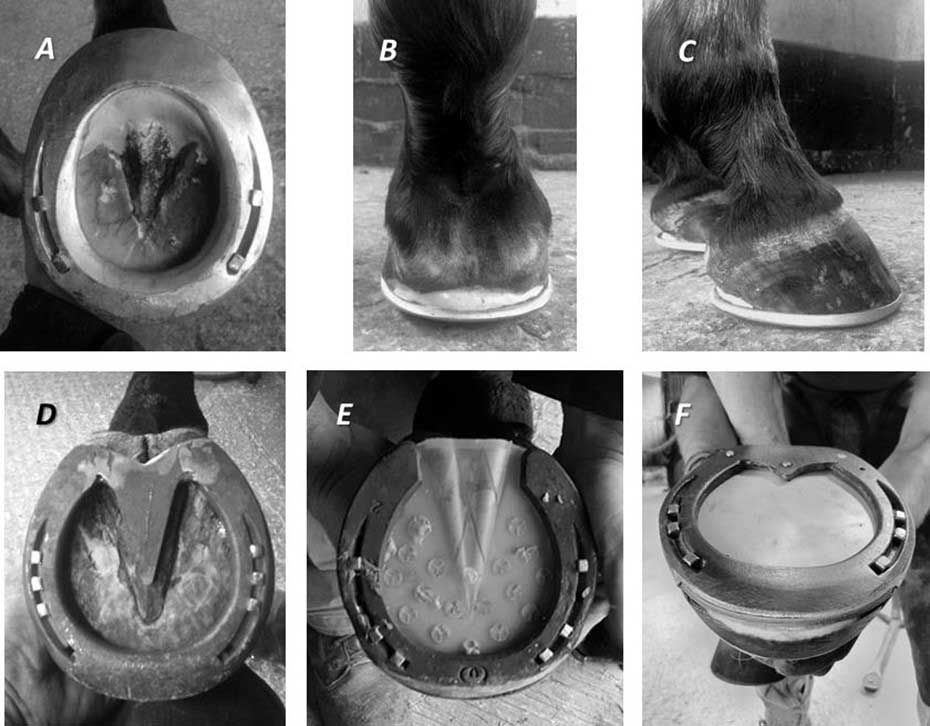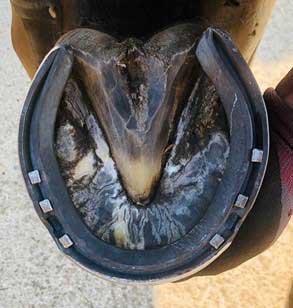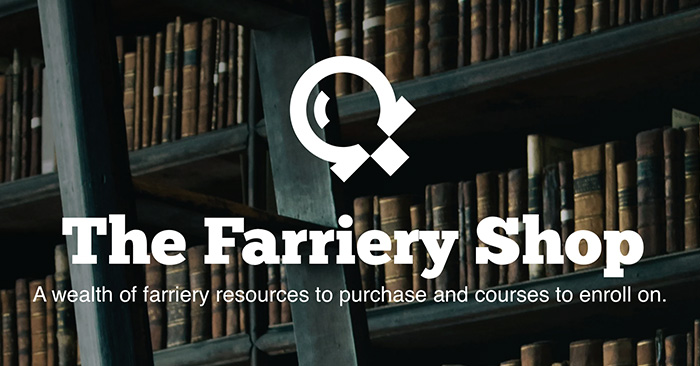Introduction:
The purpose of this text is to focus on the most useful knowledge for formulating the principles and objectives of hoof care and shoeing. It is intended to enhance the awareness and practice of all equine professionals, as well as owners and riders. It is hoped that this text represents a thorough orientation in how to trim and shoe horses taking a “why and what for” approach to the subject whilst helping students of the subject to accomplish the objectives of the theory presented here by enhancing the understanding of the mechanics of trimming of hooves, fitting of shoes,
Background
The conformation of the equine hoof is considered an important factor affecting performance of the horse (Linford, 1993). Poor hoof conformation is a consequence of the anatomy of the horse and biomechanical function in high-performance activities and has been linked to risk of injury in horses (Kane et al., 1998). The equine hoof serves as the interface between the ground and the skeleton of the equine limb; its structure is capable of dissipating large forces associated with impact shock and loading. Hoof care professionals claim that the correct foot balance is critical in maintaining health and biomechanical efficiency (Johnston & Back, 2006), but the actual dimensions of the ideal hoof model have not yet been clearly defined. During the last century various models of hoof trimming and correct hoof balance, largely based on the historical works of Russell (1897) and others (Dollar & Wheatley, 1898) have been debated, yet to date there are little in the way of scientific data and agreement on the optimal model of hoof conformation (Thomason, 2007). Hoof conformation can be altered by human intervention, such as hoof trimming and the application of horseshoes (Kummer et al., 2006; van Heel et al., 2005).
Soundness in the equine foot relies on the three primary optimal functions of the foot—impact, all affect the health of the horse, and all three need to be considered concurrently in diagnosing and treating foot disease. Both veterinary surgeons and farriers have observed that high stress and displacements of the hoof capsule, such as flares, dishes, rings, cracks, and imbalances which often result in pain and discomfort. Recent scientific investigations offer an improved understanding of the three functions of the hoof and can advance the farriery treatment of horses as well as improve the ability to formulate trimming and shoeing plans for farriers, who are often responsible for any foot related treatment of the diagnoses. However, empirical observation, personal experience, and pragmatism have sustained the activities of trimming and shoeing for thousands of years. Factors surrounding biomechanical dysfunction of the equine hoof and the relationship with balance and morphology have perhaps not been the focus for rigorous scientific investigation. By investigating these factors there is the potential to inform and influence equine hoof care, with the ultimate aim of preventing or limiting the likelihood of injury and disease in the equine hoof.
The art and science of horse shoeing
Farriery must be studied in the same way as any other science subject using evidence based knowledge and understanding to maximize the duration of the horses successful working life within the limits of that animals individual conformation. In order that a farrier may become successful in practice this often necessitates a compromise between the need to maintain an animal in work and the need to maintain the natural physiological function of the foot. Shoeing is both an art and a science, and by making use of this study the farrier may communicate with veterinarians, horse owners and other farriers, using terminology which is readily understood. Clear communication in this way will assist the farrier to more correctly shoe or treat the horse and to gain the maximum benefit when presented with articles, papers and books.
A sound understanding of the nature and function of the horse (and in particular the lower limbs) inspires confidence in the farrier and so will greater profit his business and the economic wellbeing of both the horse and its owner.
A history of shoeing horses
There have been different opinions expressed on the origin of the horseshoe. Some historians have credited the Druids, although there is no hard evidence to support this claim, as the first to use iron shoes as a preventative measure against excessive hoof wear. Written records describing the use of nailed shoes are relatively late, first appearing around AD 900. There is very little evidence to suggest the existence of nailed-on shoes prior to AD 500 or 600, although there are archaeological examples: a horseshoe, complete with nails, dating to the 5th century A.D. has been discovered and evidence suggests that around 1000 AD, cast bronze horseshoes with nail holes became common in Europe. Commonly the design consisted of a scalloped outer rim and six nail holes.
By the time of the Crusades (1096–1270), horseshoes were widespread and frequently mentioned in various written sources (Encyclopædia Britannica, 2005). By the 13th century, shoes were forged in large quantities and could be bought ready-made. Hot shoeing, the process of shaping a heated horseshoe immediately before placing it on the horse, became common in the 16th century and in 1751 Bridges wrote his treatise titled “No Foot, No Horse” on the proper care and maintenance of hooves, a term in continued use to this day.
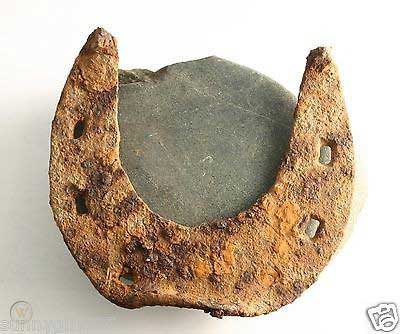
Basic Principles of good horseshoeing
The aims and objectives of this post are to stimulate debate on the fundamentals of farriery in the search of trimming and shoeing protocols that account for the individual biomechanical variation within the population, highlight the consequences that individual conformation might have on form and function of the foot. In doing so, the work will examine the role that science has played in the understanding of the dynamics of the foot under load and the role of mechanical forces on the morphology of the hoof whilst discussing trimming and shoeing methodologies that might manipulate those forces for a biomechanically more efficient model.
Empirical observation, personal experience, and pragmatism have sustained the activities of trimming and shoeing for thousands of years. Factors surrounding biomechanical dysfunction of the equine hoof and the relationship with foot balance theories and there application with hoof morphology has perhaps not been the focus for rigorous scientific investigation. By investigating these factors there is the potential to inform and influence equine hoof care, with the ultimate aim of preventing or limiting the likelihood of injury and disease in the equine hoof. To better understand the relationships this work will briefly set out the background to currently accepted hoof care and horseshoeing practices. However, any review of these practices would not be complete without an elementary discussion on the anatomy and physiology of the limbs and feet. Such a discussion is indispensable as it enables a better understanding of the relationship of the hoof to the dynamics of movement and the foot and limbs interaction with the environment and substrate. Inevitably, the interaction between the foots bearing border and the ground are governed by fundamental laws of physics, it is essential to be aware that the practical interpretation of these laws dictate the basis of analysis of evidence used to formulate the major concepts of this work
Shoeing horses has often been termed a “necessary evil.” Certainly it is not natural, but neither is the domesticated life most horses must endure. Domestication results in a separation of the horse from the natural environment and life style which directed its evolution. The “unnatural” conditions of domestication usually include wet climates, restricted activity, changes in nutrition and breeding factors, often imbalanced human “training” and, of course, trimming and shoeing. The hoof’s shape and function are direct expressions of a horse’s environment, manner of movement or locomotion, and amount and type of physical activity.
Domestication, or removal of any horses from the dry, open ranges of their evolutionary habitat and their natural, vital, socially motivated physical development, promotes potentially damaging changes in healthy hoof shape and function. Such changes in hoof shape and function can obstruct movement and imbalance weight distribution in the legs, thus leading to restricted performance or lameness in the horse. The distinctions between the natural and unnatural characteristics of hoof shape are important. And so too becomes the necessity to practice hoof trimming and shoeing in ways which promote natural and discourage unnatural hoof shape. Similarly distinctions between balanced and imbalanced locomotive behavior also become important in understanding the origins and effects of unnatural hoof shape.
The acts of trimming and shoeing only become “evil” when they fail to compensate for unnatural influences or directly promote unnatural and thus unhealthy hoof shape and function. In order to best serve the interests of the horse, and thus the horse owner, hoof care and shoeing must be founded in:
Intimate knowledge of what the structures of hoof and limb are: their anatomy and histology
Understanding of how those structures function together: their physiology and the balanced locomotion of the body it can produce under favorable conditions.
Understanding of how the above aspects and functions relate to the horse’s “evolutionary design;” both the overall development of the body and the specific shape of the hooves which contribute to the most natural or efficient, sound locomotion.
Analytical attitude that can discriminate the intricate factors involved in the complex relations of conformational and locomotive characteristics of individual horses which are dramatically exaggerated by the variable conditions of domestic environment and activities.
The historical reasons for shoeing horses
At this juncture it is worth remembering why we shoe horses. There are 5 main objectives and these are summarised in the basic functions of shoeing and hoof care. These five objectives are accomplished primarily by hoof shaping and shoeing combined with adjustments in the horse’s environment and training which promote relatively balanced or efficient locomotion.
1. Maintaining the shape of the hoof- Hoof care professionals insist that correct foot balance is critical in maintaining health and biomechanical efficiency (Johnston & Back, 2006) but the actual dimensions of the ideal hoof model have not yet been clearly defined. The debate over the correct or desired proportions and angles associated with a ‘normal’ hoof capsule and what might constitute a balanced foot has been a source of contention for farriers and hoof care professionals over many years. The focus of current farriery teaching is based on maintaining correct geometric hoof balance. It is believed that geometric balance to a prescribed model promotes the most efficient form and physiological function within the foot and limb and therefore limits injury and disease to the foot and lower limb (Butler, 2005). When discussing balance, as it relates to the equine distal limb, however, the terms conformation and foot balance are often used interchangeably; more accurately conformation describes the size and shape of the musculoskeletal structures and the way in which they are spatially arranged. Foot balance though describes the way in which the hoof capsule relates to all the musculoskeletal structures of the limb. To understand the basis of foot balance in the horse a detailed understanding of anatomical form and function is required.
Good hoof care must simulate the effects of the natural influences which directed the evolution of the hoof to produce its optimum healthy shape and function. The equine hoof encapsulates and protects the bones and sensitive structures of the distal limb. The outer hoof capsule grows distally from the proximal border to the bearing border and is generally in balance with the amount of wear that naturally occurs as the horse travels over the ground (Pollitt, 1990). The growth rate of the hoof wall has been estimated at 7mm every 28 days taking on average 9 to 12 months for a hoof wall to renew itself (Pollitt, 1990). Domestication and continued work on abrasive terrain can compromise the delicate balance between growth and wear and may lead to lameness with economic implications associated with loss of animal performance, historically; this necessitated the need for professional foot care and protection in the form of a shoe.
2. Protecting Hoof and Limb- The hoof and thus the limb and horse, must be protected from damage, injury, excessive wear, deformity and disease in order to preserve or restore healthy shape and function.
Design criteria of the shoeing plan, irrespective of fitting style, must have at its core the principle of minimizing the unintended consequences on the normal anatomical and physiological function of the lower limb and foot. Within the limits of the activity that the horse is to undertake the application of shoes should as far as practically possible maintain maximum biomechanical efficiency whilst enhancing performance and grip and preventing strain related injuries. Science has shown that physiological health of the foot is best served where all the epidermal structures are engaged in appropriate weight sharing during the stance phase (Hood et al 1997; Clayton 2011). Once attached, and by whatever means, the shoe becomes an integral part of the limbs propulsive and load bearing mechanism and as such careful consideration needs to be paid to the material selection for the shoe and how that might affect the foots interaction with the terrain or surface the horse normally works on, method of attachment and the position and nature of performance enhancing ancillary features. All will directly affect the mechanical efficiency of the whole horse. Every shoe that is applied will have unintended consequences. Careful consideration to the most effective way of mitigating the unintended consequence is a vital aspect of the shoeing plan in order to maintain the general health and function of the foot. Most importantly however differences in performance horse shoeing styles will necessitate variations in the shoeing cycle.
In order to discuss the design of a comprehensive shoeing plan, it is necessary to assesses criteria for shoeing. It is essential that a common interpretation of the anticipated use of the horse is agreed and understood by all those involved in the management, welfare and training of the horse. Terminology commonly used in farriery can often be interpreted differently, for example use the description hunter in the UK and a shoeing style based on a peripheral outline fit designed to minimize premature shoe loss and injury will be adopted by the farrier with the recommendation for a much reduced shoeing cycle. The act of farriery has been described as both art and science which has a direct influence on function of the structures within the foot. It is the author’s belief that a sound trimming technique based on anatomy and physiology of the foot is the mainstay of farriery intervention. The foot’s ability to maintain its integrity and health to from trimming alone will be dependent on the integrity of those structures and the mass or density of the foot present. Various shoes are then applied to protect or compliment what has been trimmed and to manipulate the basic biomechanical forces acting on the foot.
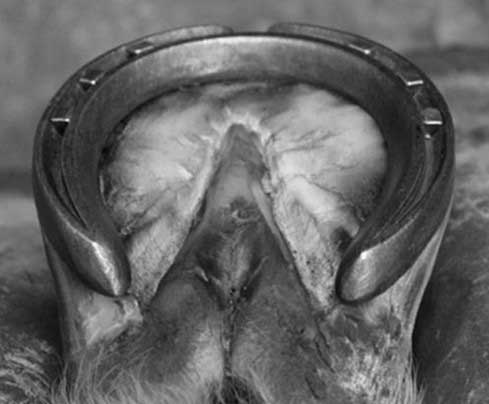
The authors approach is to employ a range of shoeing styles and techniques designed to increase the ground surface of the foot, unload areas of the foot, effect or reposition breakover, and dampen concussion to some degree. Biomechanically, these techniques can: A) change dorsopalmar or mediolateral orientation of the foot thus changing forces by moving CoP (Hagen 2016), B) reduce the forces associated with breakover (Moleman et al 2006), and C) decrease the stresses associated with the soft tissue pathologies by transferring load (Denoix et al 2001). Selection of a broad light weight material as possible, that will last the duration of the expected shoeing cycle, normally between 35 & 42 days, will minimize the energy requirements musculoskeletal system and effect a smoother transition of the individual limbs into the swing phase of the stride. Whilst the careful selection of the materials profile suitable for the intended terrain or surface will enhance the safety of both horses and rider.
3. Facilitating Locomotion- The movement of the horse should be assisted or enhanced (not obstructed) to promote athletic performance and diminish chances of injury.
The modem equine working environment necessitates consideration for the health and safety of horse and rider / driver / handler. This often necessitates compromises of foot welfare in the form of shoeing styles to maximize traction for different surfaces. The surfaces on which different working, leisure and sporting activities are practiced do not afford the same traction as dirt roads; therefore there is often a need to add to the horse’s foot some form of anti – slip device. Traction can be improved through the use of different shoe profiles or the addition of artificial ground surface projections such as studs or caulkins. However, these devices affect the delicate biomechanical relationship of the internal anatomical structures of the foot which can in turn result in increased strain of both the axial and appendicular musculoskeletal system increasing the likelihood of either interference injuries through changes in gait or repetitive strain injuries or pathologies which result in premature lameness.
4. Compensating for and managing abnormalities- Weaknesses and deformities in hoof, limb or locomotion which may cause and/or result from injury should be compensated by trimming, shoeing or training when possible. Excessive or unnatural wear can often be related to excessive or abnormal weight bearing or to loss of flexion of limb during motion for example dragging of the toe as the foot lands or as it leaves the ground (break-over). There may be a number of causes including limb and foot conformation as well as a response to pain and pathology leading to self-evident changes in the foots biomechanical interaction with the ground. For example this is often witnessed in cases of navicular lameness and bone spavin disease which frequently result in excessive wear of the dorsodistal hoof wall and a loss of solar mass. Farriery management of abnormal wear of either the hoof or shoe is often achieved by simple manipulations of the shoe such as rolling the toe of the shoe to mirror the appearance of the worn bearing surface of the hoof.
5. Provide Therapy- Causes of injury or lameness related to hoof shape and function or locomotive actions of the limb should be eliminated or alleviated when possible.
To evaluate the affects therapeutic shoeing interventions, it is necessary to define the term therapeutic farriery. Therapeutic farriery could be described as “the art and science of affecting / influencing the structures of the foot”. This is primarily achieved through the manipulation of forces to affect a mechanical advantage which will result in the relief of pain through the transfer of load, the provision of support or providing stability of off axis movement to reduce compressive or tensile strain. Often therapeutic intervention takes the form of prescriptive horseshoes for specific conditions such as the heart-bar shoe for laminitis or the egg-bar shoe for navicular disease to name but a few. In reality the myriad of these types of shoes actually offer the farrier a number of variants that can be added to standard shoes to be applied in the manner previously described. In each case these variants should be carefully selected to match the desired effect to ameliorate individual symptoms with careful consideration given to mitigating the unintended consequences and particular risks to the wellbeing and function of the foot and limb as a whole. Proper trimming is paramount to the recovery of the foot and is more important than the type of device applied to the foot. The hoof must be trimmed with the goals of establishing a normal angle, balance, and length of the foot, and eliminating diseased or distorted horn.
Proper identification and analysis of problem areas, like hoof capsule distortion, enables farriers to implement changes to landing strategies with the aim of reducing the effect of landing force by increasing the surface area and thus minimize injury. In biomechanical terms forces responsible for the stress directed over the foot cannot be eliminated. However their direction and duration can be manipulated to relieve strain. In simple terms farriery interventions can manipulate force (mass x acceleration) by creating a pushing or pulling action on the point of force trajectory. This can be achieved by adaptation of the shoe. The addition of material to the bearing surface area effectively pulls the force towards the intervention whilst the removal of ground bearing area pushes the force away from that area.
An important principle of any therapeutic shoeing plan is to dissipate load over as large an area as possible by shoeing the foot full through the heels and extending the bearing border palmarly. Historically, egg bar shoes and variants have been used for this purpose; however, the degree of extension can create a lever effect concentrating load on the edge of the heel (O’Grady 2011). Straight bar shoes, heart bar shoes, onion shoes, roller motion shoes or other wide-webbed heel devices have been used successfully to support the heels by manipulating forces across the foot. Implementation of these is however often considered impractical for long-term use in a competing athlete. The addition of solar support in the form of pour-in pads, impression material and or various types of proprietary pads can contribute to increased stability and load sharing whilst often providing temporary relief of clinical symptoms and aiding the prevention of any further reduction in integral strength of the hoof structures.
Therapeutic shoeing plans aim to (1) reduce acute pain and inflammation, (2) optimize repair of the injured tendon or ligament, (3) to reduce the effect of adverse biomechanical forces acting on the injured structure. This is primarily achieved by improving the dorsopalmar/plantar and mediolateral orientation of the foot and lower limb through trimming and the attachment of shoes designed to manipulate force and compensate for conformational anomalies. These types of modified horseshoes are primarily thought to facilitate lateral breakover during turns by reducing torque subsequently relieving compressive and tensile forces in and around the joints and the connective structures (Denoix et al 2007). A variety of horseshoes have developed with the common purpose of optimizing biomechanical efficiency of the foot and to relieve repetitive strain such as that experienced by the collateral ligaments and for the treatment of articular disorders (Gregory 2007). These types of modified horseshoes can alter the height (Side Wedge shoe), the weight bearing surface (Wide Branch or Wide Toe shoe) and/or the torsional forces experienced at breakover (Roller shoes). All can influence the biomechanics of the distal limb during stance and locomotion (Denoix et al 2007). However the effect of these types of horseshoe modifications are often surface dependent and indeed their application may be contraindicated in certain environmental and management circumstances. The unintended side effects and the individual duration the horses can tolerate them may indicate a temporary limit for the application of any modified therapeutic horseshoe. These types of therapeutic shoes are not designed to be used all of the time. The author believes however they may also have a useful role to play in the prevention of soft tissue injury where severe foot imbalance and conformational abnormalities are present.
However, the effect of these types of horseshoe modifications are often surface dependent and indeed their application may be contraindicated in certain environmental and management circumstances. The unintended side effects and the individual duration the horses can tolerate them may indicate a temporary limit for the application of any modified therapeutic horseshoe. These types of therapeutic shoes are not designed to be used all of the time. The author believes however they may also have a useful role to play in the prevention of soft tissue injury where severe foot imbalance and conformational abnormalities are present. When applied for the treatment of a specific injury, it is crucial to keep in mind that relieving certain structures of the distal equine limb immediately causes more stress on the antagonistic structures and may lead to subsequent pathologies. These shoes increase biomechanical stresses on other supporting structures of the limb, which can lead to failure of those structures (Richter 2015). The shoes are meant for use while an injury is healing and during a portion of the rehabilitation period, in general for less than 1 year. The ultimate goal is to return the horse to use of a plain shoe at the earliest opportunity. This requires that these types of shoe are adjusted as the injury responds to treatment. Often during this time the foot will change, it is essential the farrier ensures that the foot remains well balanced post treatment maintaining a foot conformation that prevents an increase in stress on the formerly injured structure.
